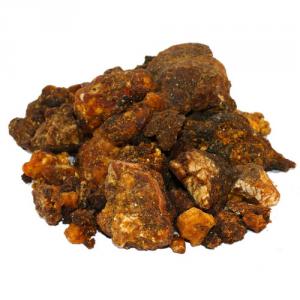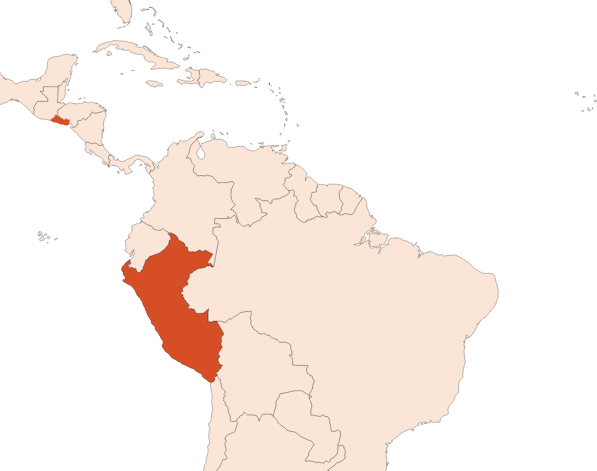Peru Balsam Resinoid
Naturelle
Balsamic Ambery > Balsamic > Vanillic > Warm Woods > Animalic

Crédits photo: ScenTree SAS
Latin name :
Myroxylon balsamum var. pereirae
Botanical profile :
The Peru balsam comes from a balsam tree of the Fabaceae family and the genus Myroxylon.
Geographic origin :
Originally from Peru, this balm is cultivated mainly in El Salvador (main producer), and still partly in Peru
Chemotypes :
The genus Myroxylon includes only two species :
Myroxylon balsamum grouping the two varieties used in perfumery : Peru Balsam Resinoid (var.pereirae) and Tolu Balsam Resinoid (var.toluiferum).
Myroxylon peruiferum : less used in perfumery.
Myroxylon balsamum grouping the two varieties used in perfumery : Peru Balsam Resinoid (var.pereirae) and Tolu Balsam Resinoid (var.toluiferum).
Myroxylon peruiferum : less used in perfumery.
Extraction process :
The explotation of balsam trees begins when the tree reaches 20 to 30 years because the trunk has a greater width and therefore, yield is better. The local people, called ''balsameros '', are responsible for strategically incising (V-shaped incision) the trunk of the tree causing an immune response and allowing the exsudation of a brown balm. This incision is usually made from January to May during the dry season and from May to September during the rainy season. Following the incision, the farmers come to apply an inflamed torch on the wounded surface. This step is essential otherwise the balm would not exhilarate. Then, they put rags directly on the trunk to collect the balm by absorbing all of the exsudate for a few weeks. Afterwards, the rags are collected and boiled to separate the balm from the fabrics.
After the balm is collected, it is diluted in alcohol to precipitate heavy and insoluble bodies. Precipitation is favored by glazing, which means subjecting the balm-alcohol mixture to a temperature gradient of 140 °F to 32 °F to obtain the resinoid.
Peru Resinoid can be distilled to be bleached, without a great olfactory deterioration -> Peru Balsam EO
After the balm is collected, it is diluted in alcohol to precipitate heavy and insoluble bodies. Precipitation is favored by glazing, which means subjecting the balm-alcohol mixture to a temperature gradient of 140 °F to 32 °F to obtain the resinoid.
Peru Resinoid can be distilled to be bleached, without a great olfactory deterioration -> Peru Balsam EO
Major Components :
Benzyl Benzoate (≈55%)
Benzyl Cinnamate (≈15%)
Benzyl Alcohol (≈1%)
Cinnamic Acid
Benzoic Acid
Cinnamyl Cinnamate
Benzyl Cinnamate (≈15%)
Benzyl Alcohol (≈1%)
Cinnamic Acid
Benzoic Acid
Cinnamyl Cinnamate
- Uses in perfumery :
- Used as a fixative for amber and vanilla notes or in floral compositions, or to bring an animalic facet to a balsamic note.
- Other comments :
- The resin is extracted by incising the Balsam of Peru, which can reach 25 to 30 meters in height. This resin is used to heal the bark of the tree.
The smell of Peru resin is more animalic than the Tolu Balsam Resinoid one, more greedy and caramelized.
In the 16th century, the Popes Pius IV and Pius V authorized the use of this balm to consecrate the holy chrism (sagrada chrisma), a mixture of essential oils used for baptism, confirmation and ordination. - Volatility :
- Heart/Base
- Appearance :
- Brown resin
- Stability :
- Solubility issues in perfumes
The esters identified in this raw material can form their corresponding acid in stability tests - Price Range :
- €€€
- Aromatherapy :
Informations provided below are taken from reference works in aromatherapy. They are given for information purposes only and can not constitute medical information, nor engage the responsibility of ScenTree.
Peru balsam has expectorant (causes coughing) and urinary antiseptics properties. It is recommended for cough, bronchitis, tuberculosis, urethritis and prostatitis (inflammation of the urethra and prostate).

Crédits photo: ScenTree SAS
- EINECS number :
- 232-352-8
- FEMA number :
- 2116
- Allergens :
- This ingredient does not contain any allergen.
- IFRA :
- This ingredient is not restricted
To learn more about IFRA's standards : https://ifrafragrance.org/safe-use/library
ScenTree is solely responsible for the information provided here.



